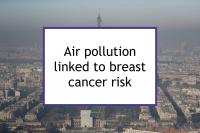Persistent exposure to air pollution has been reported to be associated with modestly increased risk of breast cancer and worse survival. Now a new study has found that long-term exposure to nitrogen dioxide (NO2), found in traffic-related air pollution, is associated with increased breast cancer risk among postmenopausal women.
Components of air pollution
Air pollution is comprised of varying fractions of ambient particulate matter, NO2, ozone, polycyclic aromatic hydrocarbons (PAHs), other organic components, metals, and other toxins. NO2 is frequently used as a marker of traffic-related air pollution.
Latest research links NO2 to breast cancer risk
The study referenced above was designed to examine the association between long-term NO2 exposure and breast cancer risk. The study included 5,222 breast cancer cases in the French E3N cohort diagnosed from 1990 to 2011, as well as 5,222 matched cancer-free controls. The French E3N cohort study was established in 1990 to investigate risk factors associated with cancer and other important non-communicable diseases in women.
To conduct the study, the authors estimated annual average concentrations of NO2 at participants’ residential addresses. Two analytical techniques (multivariable conditional logistic regression models and CHIMERE, a chemistry transport model) were used to assess the association between NO2 exposure and risk of breast cancer.
Average NO2 exposure was found to be associated with increased risk of breast cancer overall. Each increase in NO2 level was associated with greater breast cancer risk in a dose-dependent manner. When the results were analyzed by menopausal status, no association was observed among premenopausal women. Analyses using the CHIMERE model showed only slight differences in the risk estimates, reinforcing the validity of the regression model findings. The authors conclude that long-term exposure to NO2 air pollution is associated with increased risk of breast cancer.
